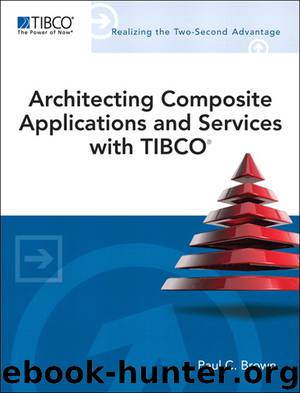Architecting Composite Applications and Services with TIBCO by Paul C. Brown

Author:Paul C. Brown
Language: eng
Format: epub
Publisher: Pearson Education Limited (US titles)
Published: 2013-03-15T16:00:00+00:00
Design Pattern: Rule Service Separated from Process Manager
There are two basic patterns for managing flow with rules. The patterns differ regarding where the rules are located with respect to the process flow logic. In one case the rules are strictly separated, and in the other they are fully integrated. Let’s take a look at the design pattern for the separated case.
In most processes where rules are employed for decision making, there are well-defined decision points in the process, each of which has relatively few outcome branches (Figure 10-5). When rules are employed in these situations, it is because the decision as to which of the branches to take is complex, even though the number of possible outcomes is small. In these cases, it is relatively easy to separate the rule service (which interprets the rules) from the process manager, as shown in the figure. The process manager asks the rule service to determine the decision result, but the process manager determines what the process should be for each result.
Download
This site does not store any files on its server. We only index and link to content provided by other sites. Please contact the content providers to delete copyright contents if any and email us, we'll remove relevant links or contents immediately.
| Coding Theory | Localization |
| Logic | Object-Oriented Design |
| Performance Optimization | Quality Control |
| Reengineering | Robohelp |
| Software Development | Software Reuse |
| Structured Design | Testing |
| Tools | UML |
Deep Learning with Python by François Chollet(12966)
Hello! Python by Anthony Briggs(10212)
The Mikado Method by Ola Ellnestam Daniel Brolund(10117)
OCA Java SE 8 Programmer I Certification Guide by Mala Gupta(10053)
Dependency Injection in .NET by Mark Seemann(9594)
Algorithms of the Intelligent Web by Haralambos Marmanis;Dmitry Babenko(8604)
Grails in Action by Glen Smith Peter Ledbrook(7949)
Becoming a Dynamics 365 Finance and Supply Chain Solution Architect by Brent Dawson(7944)
Test-Driven iOS Development with Swift 4 by Dominik Hauser(7912)
The Well-Grounded Java Developer by Benjamin J. Evans Martijn Verburg(7851)
Microservices with Go by Alexander Shuiskov(7709)
Practical Design Patterns for Java Developers by Miroslav Wengner(7602)
Test Automation Engineering Handbook by Manikandan Sambamurthy(7545)
Angular Projects - Third Edition by Aristeidis Bampakos(7025)
Secrets of the JavaScript Ninja by John Resig Bear Bibeault(6750)
The Art of Crafting User Stories by The Art of Crafting User Stories(6479)
NetSuite for Consultants - Second Edition by Peter Ries(6420)
Demystifying Cryptography with OpenSSL 3.0 by Alexei Khlebnikov(6215)
Kotlin in Action by Dmitry Jemerov(5375)
